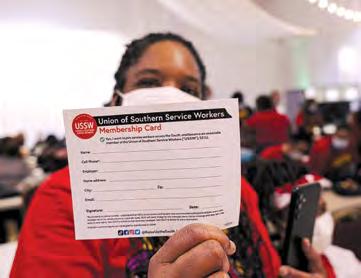We Demand We Demand






In four southern states including North Carolina, service workers have formed a cross-sector union to demand fair pay, safety, consistent scheduling, and dignity at work.

 by Lena Geller, p.4
Raleigh | Durham | Chapel Hill November 23, 2022
by Lena Geller, p.4
Raleigh | Durham | Chapel Hill November 23, 2022
CONTENTS
4 Service workers from four southern states have formed a union to demand better pay and working conditions.
BY LENA GELLER
6 The compromise Raleigh residents reached with the developer of Seaboard Station is a model for how the city can preserve its old buildings going forward.
BY JASMINE GALLUP
8 Orange County's Latinx community calls for help in addressing a growing mental health crisis. BY
CHAD KNUTH
10 Durham leaders have an ambitious plan to use federal funding to transform the Bull City's legacy neighborhoods. BY THOMASI MCDONALD
ARTS & CULTURE
12 A holiday showcase of a small-town tap ensemble that’s gone big, and a transgressiveproduction of Emma. BY BYRON WOODS
13 Black Panther: Wakanda Forever reckons with communal grief.
BY KYESHA JENNINGS
14 She Said is a stirring newsroom drama about the fall of Harvey Weinstein.
BY SARAH EDWARDS
15 The unorthodox Redstart Foods sources from local farms and delivers lively, made-from-scratch meals around the Triangle. BY SARAH EDWARDS
WE MADE THIS
PUBLISHER
John Hurld
THE REGULARS
2 Backtalk 3 Quickbait 16 Culture Calendar

Last week for print, Jasmine Gallup wrote about Raleigh’s newly elected, all-women slate of city council members and the fresh energy they’ll bring to city government. Gallup also wrote about Orange County’s new program for barn cats that’s putting feral felines to work. Readers on Instagram had thoughts about both of these stories.
Re. the barn cats:
Wrote @KARLESCALOFRIANTE: I am personally familiar with this program and can say they provide exceptional employees
Wrote @MAAMAABROWN: What a great initiative!
Wrote @DURHAMCATCOMPANY: Love this
Re. Raleigh City Council:
Wrote @RACHELPORTER: Im excited. Lets do this! Female led council.
Wrote @JAHM64: Love this!! Excited to see what these strong, smart women can do for our city!
Wrote @MIKEDPACK : they’ll bring a whole bunch of anti-growth/anti density BS which is exactly what they campaigned on
EDITORIAL Editor in Chief Jane Porter Managing Editor Geoff West Arts & Culture Editor Sarah Edwards Staff Writers Jasmine Gallup Thomasi McDonald Lena Geller Copy Editor Iza Wojciechowska Interns Chad Knuth, Lia Salvatierra Nathan Hopkins Contributors Madeline Crone, Grant Golden,
Wrote @TINA.P.LEVY: They look like they mean business!
We also got this note from reader DIANA KOENNING re. our Raleigh City Council endorsements from a few weeks ago: I was most disappointed in the Indy endorsements for the last Raleigh municipal elections, You were dismissive of the amazing candidate Terrance Ruth. So you helped Baldwin get elected.Perhaps a look at who recruited DaQuanta Copeland to run would have been in order.
You endorsed Mayor Baldwin who shut down the CACs and is rude and rejecting of public input; who did not prepare for and mishandled the BLM protests; and who is buds with a developer given carte blanche to create a
INDY Week | indyweek.com
P.O. Box 1772 • Durham, N.C. 27702 Durham: 320 East Chapel Hill Street, #200 Durham, N.C. 27701 | 919-286-1972 Raleigh: 16 W Martin St, Raleigh, N.C. 27601
EMAIL ADDRESSES first initial[no space]last name@indyweek.com
ADVERTISING SALES
advertising@indyweek.com Raleigh 919-832-8774 Durham 919-286-1972 Classifieds 919-286-6642
Contents © 2022 ZM INDY, LLC All rights reserved. Material may not be reproduced without permission.
Charlotte-style skyline.
Could be related to your out of town owner, Richard Meeker and his Raleigh family's business interests. Sadly they don't seem to care much about Raleigh retaining modest housing, affordable spaces for small businesses, or urban trees and green spaces. It's all about accommodating rapid growth. The heck with our previous lower-slung skyline, which more beautiful cities share.
Editor’s note: The INDY did not, in fact, endorse Mary-Ann Baldwin this year. Owner Richard Meeker’s family business interests have nothing to do with our endorsement decisions.
2 November 16, 2022 INDYweek.com
COVER Photo by Union of Southern Service Workers | Design by Nicole Pajor Moore
NEWS
BACKTALK
Spencer Griffith, Lucas Hubbard, Brian Howe, Lewis Kendall, Kyesha Jennings, Glenn McDonald, Nick McGregor, Gabi Mendick, Dan Ruccia, Rachel Simon CREATIVE Creative Director Nicole Pajor Moore Graphic Designer Jon Fuller Staff Photographer Brett Villena ADVERTISING Publisher John Hurld Sales Digital Director & Classifieds Mathias Marchington CIRCULATION Berry Media Group
VOL. 39 NO. 47
Raleigh Durham Chapel Hill
The Jeremy 'Bean' Clemmons Jazz Trio performs at Kingfisher on Tuesday, November 29.
(See calendar, page 16.)
PHOTO COURTESY OF KINGFISHER
Q U I C K B A I
Turkey Tough Times
BY JASMINE GALLUP & GEOFF WEST backtalk@indyweek.com
Thanksgiving dinner will be more expensive than ever this year thanks to inflation.
Nationally, the average dinner for 10 will cost about $64, or 20 percent higher than last year, according to the American Farm Bureau Federation’s annual Thanksgiving meal sur vey. The survey also shows that a traditional meal will be most affordable in the South, at an average of $58.42, compared to the cost in the Northeast ($64.02), Midwest ($64.26), and West ($71.37).

Turkey prices are also at record highs this year due to a combination of inflation, avian flu, and supply chain disruptions, among other reasons.
“The higher retail turkey cost at the grocery store can also be attributed to a slightly small er flock this year, increased feed costs and lighter processing weights,” says Roger Cryan, the Farm Bureau's chief economist.
Here are the foods driving the higher cost.
INDYweek.com November 16, 2022 3
T
Source: American Farm Bureau's Annual Thanksgiving Meal Survey
Workers Unite
In four southern states including North Carolina, service workers have formed a cross-sector union to demand fair pay, safety, consistent scheduling, and dignity at work.
BY LENA GELLER lgeller@indyweek.com
Eric Winston spent the worst months of the pandemic at a Cracker Bar rel in Durham, cooking up platters of country-fried steak and watching his coworkers die.
The deaths—three in total, all caused by COVID-19—could have been prevented, he says: when a worker initially tested positive for the virus, the restaurant’s management could have closed the dining room for a pro fessional cleaning or allowed the worker to quarantine for 14 days, as mandated by the CDC, by offering sick leave.
Instead, management kept the restaurant open and refused to provide paid time off. The worker, unable to risk losing more than a few days of pay, returned to work too early. The virus spread amongst staff, and the three most vulnerable workers, all people of color, died in quick succession.
“I was risking my life, every day, for $13 an hour,” Winston says.
Winston, a veteran service worker, has dozens of stories like this. Some years back, he was working at a Chick-fil-A when his mother had the first of three strokes. When he asked his manager for time off— not paid time off, just a few days of unpaid leave so he could take care of his mom— he was fired.
In the state of North Carolina, most of the horrific practices that service workers
endure are legal or largely unchecked, which is why Winston has spent the past nine years taking matters into his own hands.
Since 2014, when he joined Raise Up the South—the southern branch of the work ers’ rights organization Fight for $15—Win ston has organized workers at businesses including McDonald’s, Burger King, Waffle House, and Cracker Barrel, leading strikes to demand better safety policies, fair pay, consistent scheduling, and respect and dig nity in the workplace.
His efforts, a number of which sparked near-immediate change from employers, have helped to lay the groundwork for some thing that—given state and federal legisla tive blocks, systemic exploitation, and the service industry’s high turnover model—has long seemed impossible in the South: last week, Winston and more than 100 other service workers established a union.
Initially launching in North Carolina, South Carolina, Georgia, and Alabama— the first two of which bear the lowest union densities of any state in the nation— the Union of Southern Service Workers (USSW) is an evolution of Raise Up the South and will function as a part of the Service Employees International Union, a labor union that represents nearly 2 million workers in the United States and Canada.
Unlike the enterprise unions that have made headlines in recent months, such as Starbucks Workers United and Amazon Workers United, the USSW is cross-sector, offering membership to fast food, retail, warehouse, care, and all other service indus try workers in the four-state region.
According to founding members of the USSW, the cross-sector model holds a number of benefits.
The issues that service workers face are typically systemic and widespread, so join ing forces across sectors—and creating a joint list of demands—is an effective way for workers to maximize capital and collec tive power and work toward enacting indus try-wide change.
The model also acknowledges the reality that, because low-wage service jobs have such a high turnover rate, the storeby-store approach utilized by enterprise unions—in which workers vote to pass union elections at individual company locations—is extremely difficult for service workers to pull off.
“If I try to form a union at just McDon ald’s, or just Wendy’s, [the companies] can drag the process out for two, three years,” says Mama Cookie, a Durham resident, longtime labor rights activist, and found ing member of the USSW who works two service jobs. “And by that time, bam, bam, I

done moved somewhere else, all my cowork ers moved somewhere else, and there’s no one left to [vote for a union].”
(This phenomenon is currently stalling the efforts of Amazon Workers United, which has lost union elections at two ware houses—and faced fierce opposition from the company—in the months since workers made history by unionizing a facility in Stat en Island, New York.)
Cummie Davis, a Chapel Hill resident and founding member of USSW who works as a care provider and rehabilitation technician, says the cross-sector model also caters to workers who have multiple jobs, like her self, and offers employees of mom-andpop restaurants, independent retailers, and other small-scale businesses the newfound ability to unionize.
Davis, who has worked for the same in-home care service for 14 years, says she has a number of demands for her employer: offer employees the ability to work 40 hours a week, so they don’t have to work second jobs; provide additional pay for working on holidays; and compen sate workers for the hours they spend with patients overnight.
“We get paid from the time we get there to 10 o’clock at night, then we have to spend the night in their beds without pay,” Davis says.
4 November 16, 2022 INDYweek.com N E W S North
Carolina
Jamila Allen, USSW Summit emcee. PHOTO BY UNION OF SOUTHERN SERVICE WORKERS
But because Davis is one of just three providers employed at the company, and because her shifts rarely overlap with those of her coworkers, she hasn’t had an oppor tunity to organize.
Now, though, with the USSW’s cohort of service workers behind her, organizing seems more feasible.
“I have been working in the service arena for so many years,” Davis says. “And I always have felt like my back was against the wall. Do I call the unemploy ment office? Do I talk to the labor board?
[USSW], it opens the door for me. They let me know that we hear you, that we got demands, we have your back.”
As it stands right now, the union’s approach to organizing is at once broad and laser-focused.
Its universal demands for employers (compiled in a petition that prospective members can sign to receive member ship information) are as sensible as they are ambitious, with thunderous claus es like “real healthcare benefits for work ers and our families” and “protection from sexual harassment, homophobia and racial discrimination.”
“This little bit tucked in about ‘the end of wage theft’—damn!” says Gunther Peck, a Duke professor who teaches courses on labor organizing. “And ‘rights for regular work hours’—they’re naming casual labor as a problem. Who else is doing that? This union is fighting for something so much big ger. It has a sense of its moral universality. Labor movements, at their best, have done that historically.”
But before a full-fledged sea change— which, workers recognize, will likely take decades—the USSW aims to provide members with the expertise and resourc es they need to organize their individual workplaces in a way that sparks direct change without necessitating new legis lation or union elections.
This, too, is a formidable task.
Each of the four states where the USSW is active have right-to-work and at-will employment laws, which severe ly undermine union efforts and workers’ rights, as well as preemption laws, which prohibit local governments from enacting ordinances that could raise the minimum wage, require employers to provide paid leave, and otherwise benefit workers in their municipalities.
So even if workers succeed in organizing a handful of local businesses, there’s cur rently no way to ensure that those busi nesses will adhere to their promises. But that doesn’t mean that the USSW’s work will be done in vain.
“Community unionism doesn’t fit the law,” Peck says. “On the other hand, the labor movement didn’t wait to be legal to get moving. So [the USSW] can lead, and it can change practice by changing behavior, and then the law can catch up.”

One approach, Peck says, might be for the USSW to work with progressive South ern cities and advocacy groups to imple ment some kind of workers’ rights con tract—bound not by law but communi ty pressure—that employers must sign to receive approval from local patrons.
“When the division of powers in our democracy doesn’t provide checks and bal ances against abuses of power, communi ties have long had that power,” Peck says. “That’s the great thing about American rad icalism: it’s local and decentralized.”
In Durham, for instance, scores of employers have signed on to the Living Wage Project in recent years, helping to create an expectation that local business owners pay workers at least $16 an hour.
This kind of action can unleash a “moral energy” that spreads to other areas, accord ing to Peck.
“I don’t think the state legislature can abolish community,” Peck says. “I don’t think that’s in their power.”
The crowd moves as one—a sea of work ers, most in crimson shirts, that swells and folds and ripples with raised fists. This must be the red wave that everyone was talking about.
It’s Friday, November 18, and a mas sive group of service workers is ringing in the launch of the USSW at a confer ence center in Columbia, South Carolina, where they’ve coagulated for a three-day summit.

One hundred and twenty workers—40 of whom hail from Durham—spend the morning chanting, dancing, discussing their demands, and watching videos that detail the direct ties between racism and restric tive labor laws.
“For forever and a day, [corporations and legislators] have tried to prevent organizing by separating Black and white people,” says
Mama Cookie. “The USSW is a ‘race build’ as well as a union. We got to build ourselves up as a family.”
Before lunch, workers take turns stand ing at a podium and sharing stories about the injustices they’ve faced in the service industry.
Jamila Allen, a founding USSW mem ber who has organized three strikes at a Freddy’s location in Durham, discuss es the safety hazards she endured during the pandemic and proudly announces that, thanks to the strikes, Freddy’s has imple mented a COVID-19 sick leave policy at 33 of its locations.
Another worker says he experienced con sistent wage theft at a Red Roof Inn, some times getting paid for just one or two hours of work after a ten-hour shift. One speaks about the 17-hour shift he worked at a Waf fle House during Hurricane Irma. In a bare ly audible whisper, another tells the crowd that a shooting victim once came into the store where he works and died; when the body was taken away, his manager made him clean up the crime scene, he says.
Eric Winston is last to the podium. When he discusses his experiences at Cracker Barrel and Chick-fil-A, his voice remains calm, but toward the end of his monologue, he seems to receive an infu sion of emotion from the room and launch es into a rallying cry.
“This is our chance to make a change, y’all,” he says. “We built this union. We’re doing it our way.”
Workers in the crowd beat their hands on the tables, drumming up a storm. W
INDYweek.com November 16, 2022 5
Leisha Franceis holds USSW card. PHOTO BY UNION OF SOUTHERN SERVICE WORKERS
USSW group photo at launch. PHOTO BY UNION OF SOUTHERN SERVICE WORKERS
Saving Seaboard Station
Neighbors’ work to preserve Seaboard Station from demolition is an example of what is possible when it comes to saving Raleigh’s historic landmarks during a period of rapid growth.
BY JASMINE GALLUP jgallup@indyweek.com
As plans to build two new high-rises in central Raleigh move forward, a small group of neighbors is celebrat ing their successful attempt to save a piece of history.
The campaign to save Seaboard Station began months ago, after Turnbridge Equities, a New York-based devel oper, filed plans with the City of Raleigh to demolish the 80-year-old Seaboard Train Station, located near the inter section of West Peace Street and Capital Boulevard. The developer planned to build two towers on the site, currently home to Logan’s Garden Shop.
In a familiar tale, nearby residents quickly protested, with more than 100 people showing up at a local neighborhood meeting to object to the station’s destruction. Instead of overruling residents’ objections, as has been a characteris tic of the majority of Raleigh’s city council members in the last three years when it comes to development decisions, council members were persuaded to hear the residents out after a small group launched a weeks-long campaign to save the station by starting a petition, writing letters, and creating social media accounts.
Ultimately, they convinced four city council members to hold off on approving the rezoning, forcing the developer to change their plans. In exchange for permission to build up to 20 stories, Turnbridge Equities agreed to preserve or relocate at least 50 percent of Seaboard Station. Now, after the rezoning was approved in September, construc tion is expected to begin in 2025.
The story is an exciting and inspiring example of how neighbors can successfully advocate for their community. But it’s also not the whole story. Even though these Raleigh residents saved the station, their victory is one among a
slew of what they see as failures. Most of the time, run-ofthe-mill residents don’t have the time or energy to fight the change that is constantly at work in Raleigh.
“I’ve been involved in preservation projects for decades, and so were the other people who helped,” says Matthew Brown, one of the lead organizers of the campaign to save Seaboard Station and resident of Raleigh’s historic Oakwood neighborhood since 1986. “They were Raleigh’s leading preservationists … people who don’t want Raleigh to be a generic collection of high-rises and McMansions.”
Per their agreement with the city council, Turnbridge Equities is set to move half of Seaboard Station to a new location off Peace Street. The relocation process will be complex, but Turnbridge is “working with experts who spe cialize in historic building structures and moving buildings in the Triangle area,” says Jason Davis, managing director of the company.
The fact that Seaboard Station was built on an elevated slab makes relocation a little easier, says Davis. The plan is to put structures under the slab, lift the entire building, and move it 100 yards north, according to a report from the Triangle Business Journal
The original ticketing and waiting areas of the station will be preserved, while public plazas will be added on the north and south ends of the station, meant for public events and future retail, Davis says.

“Specific uses for the station building will be determined closer to construction start,” he adds.
Brown says he’s satisfied with the outcome of this rezon ing case, but it’s hard to see other quasi-historic buildings in Raleigh continue to be torn down. While he and oth
ers were fighting hard to save Seaboard Station, the city council continued to hear and approve rezonings with little resistance from residents.
Whether that’s a good thing or a bad thing depends on whom you ask. Brown says he’s happy with the city’s drive to approve infill development, such as redeveloping surface parking lots and other mostly empty areas of land. He also doesn’t mind developers tearing down rundown houses or commercial buildings that have become eyesores.
But Brown says he does object to developers tearing down Raleigh’s “beautiful historic monuments,” even those, such as Seaboard Station, that are not officially protected by historical status.
“I want to live in an interesting place, and I want to live in a beautiful place,” he says. “The old buildings … all have a story. I mean, [Seaboard] Station, there were a dozen trains a day that stopped there. This is where soldiers were sent off to World War II and came back from World War II and met their families. And if you take it away, then people can’t show their children. Every old building has some kind of story like that.”
Brown argues that the recent election results, which saw four newcomers elected to the city council, shows people want a city council that will stand up to developers and leverage rezonings to get something in return.
“This last election certainly sent a message that four new people were elected who are not supported by the develop ers,” Brown says. “[They’re] a little more responsive to just the citizens rather than the big money.”
In the meantime, Turnbridge is moving ahead on their plan to build two towers on the lot formerly known as
6 November 16, 2022 INDYweek.com N E W S Raleigh
A rendering of Turnbridge Equities plans for Seaboard Station RENDERING COURTESY OF THE DEVELOPER
Seaboard Station. The development will be mixed-use, which means it will include a mix of retail and residential space. Accord ing to site plans, the project will include 680 apartments, a mix of studios and one-, two- and three-bedroom units. It will also include three 922-square-foot townhomes with street access.
The ground floors of the 16- and 20-story towers will mostly be home to retail space (11,826 square feet) as well as amenities such as a gym, swimming pool, bike stor age, clubhouse, and green spaces (26,641 square feet). There are also plans for a 270,700-square-foot parking garage lined with residences.
The project is expected to cost about $200 million and be built in two phases. The first phase, starting in 2025, will take about two years to finish, and deliver 300 apartments along with half the parking garage. The second phase is expected to take an additional two years to complete.

As the project moves forward, Davis says Turnbridge is “committed and excited to the continued pursuit of relocating the beloved train station building, which was not previ ously a requirement for the parcel due to its lack of landmark designation.”
The developer has a record of “contex tually-sensitive” development, Davis says, citing the company’s preservation of the historic Creamery building on Glenwood Avenue and the Mutual Tower in Durham. Turnbridge also plans to preserve the origi nal warehouse buildings in its West Martin Street development, Davis says. The com pany purchased a parcel spanning 307-313 West Martin Street in the Warehouse Dis trict earlier this year.
“As we’ve seen firsthand with our projects in the Triangle, it’s clear that the people who live here care deeply about preserving the parts of this area that define its char acter and are simultaneously committed to collaborating to steer growth in meaningful ways,” Davis says.

“It’s rewarding to be able to develop projects that provide many benefits to res idents and businesses while honoring sig nificant buildings in the community. Ulti mately, the historic preservation aspects of these properties add to the character of the new construction surrounding them.” W

INDYweek.com November 16, 2022 7
“The old buildings all have a story.”
Crying for Help
Members of Orange County’s Latinx community held a forum last week to call attention to the community’s growing mental health crisis.
BY CHAD KNUTH backtalk@indyweek.com
The auxiliary room in Chapel Hill’s Binkley Baptist Church quickly filled to capacity on Thursday night as impassioned members of Orange County’s Latinx com munity gathered for a mental health public assembly. Overwhelmingly, they were concerned about the ongoing and ever present mental health crisis in their community.
“We ask ourselves what keeps you awake at night?” Luis Royo, a deacon at St. Thomas More Catholic Church, said to open the event. “Latino leaders have sounded the alarm.”
According to the National Alliance on Mental Health, more than 18 percent of Hispanic or Latinx adults in the United States experienced mental illness in 2020, a per centage not too dissimilar to the reported 22.6 percent of non-Hispanic white adults who experienced mental illness that same year. However, the Hispanic community has been disproportionately under treated due largely to a lack of funding and bilingual care.
“[In the Latinx community], when our people build up the courage to speak, they often cannot find where to go. Unfortunately, it is a silent crisis,” Royo continued. “Churches are often the first place that a Hispanic person goes for help, and without institutions that offer help in their language, churches become the only place they can turn. Today can be the day this changes. We have lost too many lives from mental health crises.”
For many years, undocumented immigrants and those in the Latinx community supported by Medicaid who suf fer from mental health illnesses, substance abuse, and developmental disabilities relied almost entirely on a sin gle local nonprofit, El Futuro, one of the few organizations working in Orange County to provide mental health care service to the undocumented and Latinx community.

But due to ongoing issues with funding—which Cardinal Innovations Healthcare Solutions, the managed care organization (MCO) serving Orange County at the time cut in 2012, and El Futuro having to absorb the cost of treating undocumented immigrants ineligible for Medicaid—the nonprofit closed its Carrboro location in 2015, leaving the local Latinx community in the lurch and needing help.
“We are in a deep, deep hole, but that is why we are here,” Royo concluded. ”We want to come out as a community united.”
the MCO responsible for dispensing state and federal Medicaid dollars in a 15-county region that included Orange and Chatham, made headlines for excessive CEO pay, luxurious board retreats, and apparent mismanage ment of government funding, allegedly hoarding $70 million that was intended for patient services. Cardinal Innovations was accused of paying it CEOs over $1.2 million more than the state permits without attaining proper approvals. Cardinal’s CEO at the time, Richard Topping, was reportedly receiving more than $600,000 a year in 2016, well over the government statute’s man dated limit of just over $187,000.
At the end of last year, North Carolina’s health depart ment shifted the responsibility of providing mental and behavioral health services for Medicaid patients away from Cardinal Innovations and over to Alliance Health. But members throughout Orange County’s Latinx com munity are worried about the transition.
Leaders from the nonprofit groups Orange County Justice United and the North Carolina Congress of Lati no Organizations organized last week’s assembly. Several Orange County commissioners and representatives from Alliance Health—the MCO now responsible for administering publicly funded behavioral health care services to Medicaid members and the uninsured in Orange and four other counties—joined the assembly to discuss a list of proposals set forth to better treat mental health within Orange County’s Latinx community.
Orange County’s mental health crisis isn’t new, howev er. It came to a head back in 2013 when the aforemen tioned Cardinal Innovations Healthcare Solutions, then
“Tonight I am pleading for our state representatives and leadership from Alliance Health to take this very serious ly, because it is a crisis,” said Diana Huerta, an Orange County resident who lost a family member eight years ago to suicide. “I can’t imagine all the suffering that he went through. A lot of people need help. We are crying for help.”
Huerta was one of three who gave personal testimonies at the assembly; two other attendees said they were angry and frustrated with the lack of initiative local leaders have shown toward the community’s mental wellness.
“This did not happen by accident,” Katherine Ward, a psychologist and cochair of the research team for mental health at Justice United, said at the event. “This happened from lack of interest.”
8 November 16, 2022 INDYweek.com N E W S
Orange County
L to R: Alvaro Alvarez, Juan Carlos Nuñez, Katherine Ward, Luis Royo, Diana Huerta
PHOTO BY BRETT VILLENA
“We are in a deep, deep hole, but that is why we are here.”
Ward said the community was no longer willing to settle for less than what it rightfully deserved.
“Alliance Health has the opportunity to correct the mistakes of the past,” Ward continued, “[but] in order to be recognized by Alliance, we need to be organized as a community and share a collective power. We need to have a concrete proposal, and that is why we are here today, with clear and precise proposals.”



Ward continued by reading the list of pro posals from Orange County Justice United. First, the group demands the creation and maintenance of a guide to mental health services for the Latinx community. Second, it demands more resources for mental health group sessions (including workshops). Third, it demands investment in commu nity health workers who are equipped to provide basic mental health services. And lastly, the group wants community leaders to ensure that Orange County’s future Cri sis/Diversion Facility has bilingual, culturally responsive staff and that invests in bilingual therapist retention and recruitment.
Ward’s proposals were met with applause. Orange County commissioners and Alliance Health representatives took the stage shortly thereafter.
“During the COVID pandemic, mental health needs have grown exponentially for all of Orange County, the state, and the world,” said Orange County commissioner Amy Fowler. “We are all here tonight because we care, and we want to hear how to serve you, and all of Orange County residents.”

Fowler, a pediatrician, shared with the room her daily experiences with patients suffering from mental health issues and their fight to find treatment.
Following Fowler’s and other local leaders’ remarks, representatives from Alliance Health took the stage, including Alliance Health COO Sean Schreiber.
“Alliance formally believes that one of the best things we can do in every com munity is expand behavioral health care,” Schreiber said. “It’s a huge issue, not just in these communities, but nationwide.”



“As the local mental health authority and funder of services, we often get lots of proposals,” he continued. “What I found so encouraging about this proposal is that the first ask was for good partnership, and it’s really much easier to move forward with these kinds of initiatives when you have good partnership.”
Marcus McFaul, a reverend with Bin kley Church, ended the assembly on a hopeful note.
“Today is a new day,” he said, arms spread in prayer. “The light has come out; the sun has come out.” W
INDYweek.com November 16, 2022 9 A pay-what-you-can cafe. 919-307-8914 | W Hargett St #50, Raleigh, NC 27601 Come visit us and join our 2020 Coffee Club unlimited coffee, tea, & iced coffee for the year A Place at the Table provides community and good food for all regardless of means. We are serving everyone. We believe that all people deserve dignity to eat in a restaurant and have a healthy, affordable meal. Wherever you may come from, you are welcome to dine with us. We hope you will. BILL BURTON ATTORNEY AT LAW Uncontested Divorce Music Business Law Incorporation/LLC/ Partnership Wills Collections 967-6159 SEPARATION AGREEMENTS UNCONTESTED DIVORCE MUSIC BUSINESS LAW INCORPORATION/LLC WILLS (919) 967-6159 bill.burton.lawyer@gmail.com Wka e up withus Local news, events and more— in your inbox every weekday morning Sign up: INDY DAILY SIGN UP FOR THE
Durham’s Marshall Plan
Durham leaders say federal funding can transform the Bull City’s legacy neighborhoods.
BY THOMASI MCDONALD tmcdonald@indyweek.com
One can’t say it enough: it took the Europeans less time to rebuild an entire continent after World War II than it has taken the city of Durham to rebuild the Hayti District after urban renewal more than a half century ago. But with a blue print for a local Marshall Plan in hand, Durham leaders say they’re trying.
Earlier this month, Mark-Anthony Middleton, the city’s mayor pro tem, foreshad owed a federally funded multimillion-dollar plan that will usher in substantive revi talization efforts along the Fayetteville Street corridor where Hayti is located, and other historically Black underserved “legacy” neighborhoods.
The funding for the proposed proj ects will come from the Biden Admin istration’s American Rescue Plan Act of 2021 (ARPA) that provides direct aid to American citizens in an effort to reduce the pandemic threat and help with the nation’s economic recovery.
On January 6, Durham received about $51 million in ARPA funding. The city coun cil allocated $7.2 million in hazard pay to city employees, and in May allocated about $20 million to more than 34 nonprofits across the city to address housing stability, economic equity, health and wellness, along with community resilience.
Middleton hopes about $22 million
remaining in ARPA funding will be used to implement a municipal plan inspired by the Marshall Plan that the United States enacted in 1948 to rebuild western Europe after World War II.
Hayti was once the site of hundreds of businesses and thousands of homes. The historically Black community was destroyed by an ill-titled urban renewal program that began in the early 1960s.
In his biography of famed Durham jour nalist Louis Austin titled Louis Austin And the Carolina Times, NC Central Universi ty historian Jerry Gershenhorn noted that, from the outset, Durham’s Black commu nity widely accepted the controversial con cept of urban renewal when it was first introduced to Durham voters in 1962 as an $8.6 million bond referendum to finance water, street, and sewer improvements in Hayti. In the following two years, some Black residents expressed “satisfaction with their move to better homes.”
“Despite its promising beginnings, urban renewal proved to be a disaster for Hayti,” Gershenhorn wrote. “After urban renewal and the building of the East-West Express way [NC Highway 147], Hayti was virtually unrecognizable. Where hundreds of homes and businesses once stood, an expressway and weeded lots stood. Many Hayti resi dents bitterly declared that ‘urban removal’
was a more apt name for what had hap pened to their community.”
Middleton is mindful of this history.
“Folks have been talking about this for a long time,” Middleton says. “I’m basically channeling what people have been talking about since Highway 147 jacked us up.”
Middleton says the rebuilding of Hayti is a goal the entire city should coalesce around because the entire city will benefit from the venture.
“The Fayetteville Street Corridor where Hayti is located should be another Sweet Auburn in Atlanta, or Sugar Hill in Harlem,” he says, referencing two of the nation’s fore most and historic Black American districts, which are both listed on the National Reg ister of Historic Places.

Hayti, too, Middleton says, should be among the city’s destinations “that attract people from all over the world,” and that its historic sister neighborhoods like Merrick-Moore and Bragtown “should be lifted up, as calling cards for the city, just like the American Tobacco District, Research Triangle Park, and even the ghost of Black Wall Street.”
Council member Leonardo Williams, who co-owns a Zimbabwean restaurant with his wife Zweli, says part of the funding should be used to support start-ups and existing businesses. He points to funding
given to nonprofits like the one renovating and retrofitting the commercial kitchen at the former Pearson School, now known as Student U in Hayti, that will serve as an incubator for Black-owned food business es, or Provident1898’s “Black Wall Street Hub” that wants to connect the city’s small business owners for mutual support and sustainability.
In addition to support for small business es and start-ups, Williams says the federal funding should be used to address the caus es of housing instability in the city’s most vulnerable neighborhoods, creating access to jobs that pay a living wage, and build ing public-private partnerships that relieves residents of medical debt.
“We can’t give people money,” Williams explains, “but we can remove the financial pressure, and position them to live better.”
The federal funds from President Biden’s rescue plan is a different animal from what is typically awarded to municipalities. This time around, the funding allows Durham’s elected leaders to consider a Bull City reparative justice model to address the dev astation of Hayti, along with the system ic underinvestment of similar communities across the city.
Middleton says that typically when cit ies and towns receive federal funding, the money has already been earmarked toward
10 November 16, 2022 INDYweek.com N E W S Durham
Heritage Square in the Hayti neighborhood.
PHOTO BY BRETT VILLENA
specific projects—roads and policing, for instance—or for initiatives like the Durham Housing Authority’s proposal demolishing the 50-year-old Liberty Street apartment complex to rebuild affordable housing east of downtown. The DHA received $40 mil lion from the federal Department of Hous ing and Urban Development’s Choice Neigh borhoods program, an initiative aimed at redeveloping distressed public housing and improving surrounding neighborhoods.
“The ARPA funding offers an off-ramp to do something creative and out of the ordi nary,” Middleton says.

Municipal leaders and city staffers are trying to figure out how to best deploy the federal dollars in a manner that creates healthy, life-affirming options for commu nity members. The city council has reviewed 80 community proposals and considered input from more than 300 city residents through a series of meetings and surveys.

Among the community members’ top pri orities are safe and healthy affordable housing, access to healthy food and mental health services, an increase in teachers’ pay and afford able child care, a living wage and more support for businesses that reflect the city’s diversity.
“The mayor and I have talked about this from time to time, and we both think this is an opportunity to do something transfor mational,” Middleton says.
Four months after her historic election in Novem ber 2021 as Durham’s first Black woman mayor, Elaine O’Neal, during her first State of the City address, lamented what she called the city’s two Main Streets.
“On one end of Main Street, you see the high-rises, shops, and amenities that illustrate the leaps toward prosperity that many have experienced over the last few years. On the other end, you see a commu nity that has not kept up with the prosper ity,” O’Neal said, while promising the city would rebuild Hayti.
O’Neal echoed Middleton’s sentiments last week when she told the INDY that the goal for the remaining funds is “to do something transformational” for the city’s legacy communities that she and the mayor pro tem agree have endured decades of devastation as a consequence of redlin ing, urban renewal, underinvestment, and over-policing.
“I want to make sure that the local folk
are included,” O’Neal says. “I’m more con cerned with the neighborhoods that have been left out of the city’s growth.”
The mayor later added that one of the things council members and city staffers learned through surveys was that “a lot of our elderly residents have no access to the Internet,” and that “justice-involved com munity members are facing barriers for housing, or even applying for housing.”
“There are lots of people in our city who have paid their debt to society but can’t find housing,” O’Neal adds. She notes that many Durham residents, even middle-class residents, are “struggling with housing.”
“It all starts with a stable living con dition,” she says. “We have to figure out how to best access homeownership, and how to help people who already own their homes stay there.”
She points to families who face the pros pect of losing public housing if a child in the home has a criminal record, and par ents who have to decide if they should leave or hide their child.
“This has gone on for an entire generation,” she says. “There are people in this city who have never had access to stable hous ing. African Americans as a whole never had housing stability from the time we got off the slave ships.”
O’Neal says Black military veterans were barred from government-backed mortgages that led to a post-World War II housing boom that has contribut ed to the racial wealth gap.
“We did not benefit. We were never a part of that,” she says. “We weren’t able to have that and have been unable to build upon that.”
O’Neal says the issues are systemic challenges that have long bedeviled the city’s legacy communities. She thinks part of the federal funding should be used to create a multifaceted community wellness hub.
She also envisions smaller hubs—“a onestop shop for folks”—in different communities all over the city that can respond to residents’ needs more effectively by “engaging in an ongoing dialogue with specific neighborhoods.”
“Government is burdened with being reactive. We need to become proactive and get into responding quicker,” the mayor says. “We are going to have to get into the weeds. This is not sexy work. This is hard work.”W
INDYweek.com November 16, 2022 11
“This has gone on for an entire generation. There are people in this city who have never had access to stable housing.”
STAG
North Carolina Youth Tap Ensemble | Riverside High School, Durham Saturday, Nov. 26, 4 P.M. | ncyte.org/homecoming

New Leaps
A showcase of a small-town tap ensemble that’s gone big, and a transgressive production of Emma.
BY BYRON WOODS arts@indyweek.com
Michelle Dorrance, Luke Hickey, and Elizabeth Burke are three of the world’s greatest tap dancers, living and working at the highest level of profession al achievement in New York City. Since all three dancers grew up here, it’s no coinci dence they’ll be back in town this weekend. But their holiday to-do list has a bit more than a chow down with the family.
That’s because all three got their start in dance in Chapel Hill, in the North Carolina Youth Tap Ensemble (NCYTE). All credit the unassuming small-town company for a large part of making them who they came to be. And when the company celebrates its 40th anniversary with a homecoming concert Saturday afternoon, they’ll be on stage, giving their all.
“It’s literally better than a high school reunion,” says Dorrance, artistic director of Dorrance Dance and a 2015 MacArthur “genius grant” award recipient. “A reunion’s just one class from high school. This is like every class—some of us were eight when we joined the company, and there were eightto 18-year-olds that we were close with during our time there as we grew up.”
It’s ironic that NCYTE remains one of the better-kept secrets in the region’s performing arts scene due to the touring company’s rare local public performanc es. Its national reputation is secure as a tap-dance hothouse that’s produced more than its fair share of luminaries in tap since its beginnings in the 1980s. Among recent graduates, alumnus Jared Grimes nabbed a Tony Award nomination this year for his performance as Eddie in the Broad way revival of Funny Girl, after a recur
ring role in Manifest and a starring role in Swing Kids on Netflix. You can catch Juba Graybeal’s latest work in the just-released Ryan Reynolds and Will Ferrell holiday film, Spirited. (His younger sister, Makayla, is a senior in the company this year.)
With a rep that distinguished, Dorrance has tens to add that no one will be phoning in a performance for this weekend’s one-off reunion show, where some 30 company alums will join the current cohort of 36 on stage.
“Elizabeth and Luke visited a rehearsal a few weeks ago, and they’re killing it,” she laughs. “[But] we can’t rest on our laurels; we have to come back and slay these danc es, and not be the ones that mess them up because we’re overconfident jerks.”
Different subgroups will perform works by company founder Gene Medler and challenging guest choreographers including Dorrance and Ayodele Casel. A live jazz trio featuring bassist Robbie Link, Jim Crew on keys and drummer John Hanks will take on composers from Billy Strayhorn to Vivaldi.
But how does a small-town company make a reputation that big in the world of tap dance? Repertory is important, accord ing to Janet Eilber, co-artistic director of Chapel Hill Dance Theater: combining well-researched ethnic dance from differ ent parts of the world with contemporary cutting-edge choreography from dancemak ers like Savion Glover.
“Both have just stood the test of time,” Eilber says.
Everyone also cites the unconventional leadership that Medler, a dancer who has taught at the American Dance Festival in
Durham and international festivals from Russia to Rio de Janeiro, has brought to the long-running group.
“As a director, he’s been more someone who has walked alongside his students, rather than in front of them,” says former student and company manager Caroline Vance. “He’s given them all of the tools and trusted them to make decisions. The freedom he’s given his students is some thing that is very rare.”
“He asks us, ‘Whose company is this?’ and the correct response is, ‘My company,’” Hickey says. “We all feel a sense of compa ny ownership.”
Diversifying ownership diversified respon sibility in turn among his students. And teaching by example that artists “dance to express, not impress” and serve an art form and their company before themselves put a healthy check on egos in a field where they can easily be all-consuming.
“Gene really empowered us,” Dorrance says. “He’s the reason we feel this con nected, the reason we feel like family. It’s the revolutionary notion that the youth shall lead us, and we are the people we are because of it.”
She cites her company’s existence, diver sity, and resilience, being able to “really push hard into this space that tap dance wasn’t always welcome” in a concert dance world, and concludes, “That’s all due to NCYTE. Right.”
Now semiretired, Medler modestly deflects questions about his contribution to the world of tap: “I don’t speculate too much about it, until maybe after a glass of wine.”
These days, he’s most excited about how students, famous and unknown, are passing the art form on.
“It’s not just that they’ve become beau tiful dancers,” he says. “They’ve become— and this is coming from an old hippie— beautiful people.”
Burke recalls idolizing older company members like Jared Grimes “with my little kid brain” when she was starting out in NCYTE as an eight-year-old. Being back in the rehearsal room with them now, “they’re still like my cool older cousins,” she says.
“Not only is everyone extremely talented, but every personality and energy in that room is so unique, and we gel in this really special way.”
Hickey was a high school senior in NCYTE during the company’s 30th-an niversary homecoming. The experience is “really empowering for students who are trying to find their way and figure out who they are,” he says. Hickey calls the interplay between alums and current company mem bers “a really tactile way of seeing where they can go and what they can achieve, whether in tap dance or other avenues. It’s about knowing this is a part of their lineage for the rest of their life.”
12 November 16, 2022 INDYweek.com
A scene from the last homecoming concert. PHOTO COURTESY OF NORTH CAROLINA YOUTH TAP ENESEMBLE
HOMECOMING
E 40TH ANNIVERSARY
CONCERT
EMMA | HHHH PlayMakers Repertory Company through Dec. 4 | Playmakersrep.org
P layMakers Rep’s Emma marks the sec ond original adaptation of Jane Aus ten’s novel that the region has seen this year. Sweet Tea Shakespeare’s May pro duction at William Peace University may have been easier on the eyes and ears than director Meredith McDonough’s gear- and culture-jamming approach to Kate Hamill’s self-aware (and, occasionally, self-congratu latory) 2019 adaptation.
But that’s entirely by intent, as both art ists here are a lot more pissed off at the Regency era that left the women of Britain in life-long mental dry dock.
“An active mind must have occupation, or it will come to mischief,” feisty actor Jamie Ann Romero’s Emma advises us in the play’s opening moments to justify her meddlings as a self-styled matchmaker in the village of Highbury.
That mischief arrives soon enough when Emma diverts a would-be protégé, actor Kimberly Chatterjee’s bland Harriet Smith, from a romance with a groundskeeper. Emma’s class-based prejudice diverts Har riet into the trajectories of other charac ters in this claustrophobic society, includ ing Emma’s bête noire, Jane Fairfax (a non plussed Sanjara Taskar), supposedly most available suitor Frank Churchill (Jamar Jones), and the ever-exasperated George Knightley (Eric Bryant).
But Hamill’s psychoanalysis of the 1810s insightfully asserts that such social intrigues are the last refuge of women not permitted any other social, economic, or intellectual outlet. It falls to Mrs. Weston (Rasool Jahan) to point out that in a world where women cannot work, own property, or serve in the courts, “a lady who is not allowed real employment will create and destroy tiny worlds in an attempt to have any stimulation at all!”
To make that point and do justice to that time and this, Hamill takes her adap tation well off Austen’s pages at points. After a memorable second-act meltdown, Emma shakily says, “You don’t remember THAT from the novel, huh?”
And McDonough emphasizes the most irritating elements of Hamill’s various char acters here: Jeffrey Blair Cornell’s unctuous, gruel-pushing Mr. Woodhouse, Adam Val entine’s overweeningly romantic Mr. Elton, and Amber Nicole Guest’s shrill Miss Bates, amid jarringly anachronistic transitions to music from Boyz II Men, the Beach Boys, and Lizzo. In commenting on an era deter mined to impose sense (and sensibility) deprivation and cultural brain death on women, it is appropriate to be discomfited. This provoking, thought-provoking produc tion fills that bill. W
Future Forward
BY KYESHA JENNINGS arts@indyweek.com
n Black Panther: Wakanda Forever, direc tor Ryan Coogler creates space for com munal grief and challenges viewers to think more deeply about the impact of colonialism. The film is the highly await ed sequel to Marvel’s record-breaking Black Panther (2018), which grossed over $1.3 billion worldwide. Two years later, in 2020, the sudden death of Black Pan ther star Chadwick Boseman from colon cancer left fans of the Marvel franchise distraught and confused.
The cinematic introduction to Bose man’s character, T’Challa, was one of the first times that a superhero film was directed by and starred Black artists. Boseman’s presence is missed and felt throughout the film, but it is the begin ning of Wakanda Forever that most pierce the emotions of viewers.
Afro-futuristic depictions of Africa and Africans and the recurring theme of divideand-conquer remain present in Wakanda Forever, but this time, Coogler invites view ers to consider other futures and futur ism. We are introduced to a new villain, Namor (also known as the god-like figure Kukulkán), played by Mexican actor Tenoch Huerta Mejía. Namor represents Indige nous peoples from Mexico, and Coogler’s reimagining of the character and his home land of “Talokan” not only makes him a unique aquatic superhero but also posi tions him to fit neatly into the Black Pan ther political universe—as if this is where he always belonged.
Namor is a villain with admirable traits. His strength is like no other, and he has the willpower to rage against all coloniz ers in a manner very familiar to Wakan dans. The addition of Indigenous charac ters with Mayan and Aztec roots allows the film to highlight the importance of interethnic solidarity.
The film’s beauty reverberates through out its cinematography, wardrobe, and
outstanding emotional performances from the cast. The underwater scenes in Nam or’s kingdom of Talokan are truly breath taking. It’s a credit to the actors’ fluid body language, the imagery, and the ocean-blue color palettes. In each scene, the ward robes matched the mood effortlessly, whether it was armor for war or ceremo nial garb to bury the dead.
In addition to Tenoch Huerta Mejía’s standout performance, Angela Bassett as Queen Ramonda thoroughly embodied the role of a wife mourning her husband and a mother mourning her son. The tone of her voice and her ability to toy with volume allows her to come across as a grieving mother full of rage but equally empathet ic to everyone else’s needs. Letitia Wright (Shuri), Lupita Nyong’o (Nakia), and Dom inique Thorne (Riri Williams/Ironheart) also had equally impressive performances.
While it was nice to see another example of Black Girl STEM magic on screen (and for Wright’s character to have an appren
tice), the film does fall short in its introduc tion of Thorne. When she appears missing, there is no mention of concerned family members, and the Wakandans just release her back to her “normal” life without much said. Is this the end of Riri in the Wakanda universe? We’ll have to wait and see.
Because of the groundbreaking success of the first film, comparisons are to be expected. And while the sequel is good in its own right, it lacks the charisma and humor that its predecessor maintained throughout. But there’s also something to be said about the way each charac ter is grieving in their own way, both in real life and on-screen. And when in the depths of grief, there aren’t many things to laugh about.
As we remember T’Challa and the life of Chadwick Boseman, the film’s end lives up to its name, Wakanda Forever. With a delightful surprise, it breaks the melan choly mood and reminds us that the Black Panther will forever live on. W

INDYweek.com November 16, 2022 13
With the death of star Chadwick Boseman still fresh, Black Panther: Wakanda Forever tells a stirring story of communal grief.
I
Angela Bassett as Queen Ramonda in Black Panther: Wakanda Forever PHOTO COURTESY OF DISNEY
S C R E E N
BLACK PANTHER: WAKANDA FOREVER | HHHH Now in theaters
Now playing in theaters
Taking Down Power
She Said is a quiet, gripping procedural about the fall of Harvey Weinstein.
BY SARAH EDWARDS arts@indyweek.com
I
n an opening sequence of She Said, reporter Megan Twohey (Carey Mulligan) interviews a woman who appears to be very afraid. It is 2016 and the woman is trying to decide whether or not she will go on record about her experience of sexual misconduct by a presidential candidate. The candidate is Donald Trump; the woman decides to go on the record. The piece is published. The woman is hounded. Despite dozens of accusations to follow, Trump goes on to win the presidency.
This disquieting recent era is the backdrop of director Maria Schrader’s new drama about the two New York Times journalists who broke the story of direc tor Harvey Weinstein’s widespread sexual predation. The reporting was pivotal not only because of the director’s influence in Hollywood—he helmed an empire that knew about his behavior and protected it—but also because it helped ignite the #MeToo movement.
In the film, Twohey—played to keen, knowing effect by Mulligan—is struggling with postpartum depression and is initially reluctant to join fellow reporter Jodi Kantor (Zoe Kazan, who is earnest but sinks into her role less comfortably) in investigating a tip about Weinstein. She wonders, under standably, if there are ever consequences for sexual misconduct, given that the coun try just elected Trump, and also whether actresses are the right avatars for this kind of investigative journalism.

But Kazan persuades her, countering
that the issue is deeply systemic: If even powerful movie stars can be shamed and silenced, what chance do regular women have in their own workplaces? The two jour nalists start digging, aided by an all-star cast of other Times journalists including editor Rebecca Corbett (Patricia Clarkson, layered in chunky jewelry and deserving of more screen time) and executive editor Dean Baquet (Andre Braugher). They know that the story goes deep, but Weinstein’s victims—from former assistants to famous actresses—are terrified to speak up, bound, as Twohey and Kantor discover, by layers and layers of non-disclosure agreements and settlements.
Then comes the procedural Journalism Movie shots, familiar but competent and comforting: the reporters bustling through New York City morning traffic, sensible backpacks strapped on and chalices of cof fee in hand, then, making calls, pounding pavement and door knocking, then, more calls. They meet with actresses who have been harmed by Weinstein (including Ash ley Judd, who plays herself) and try to per suade them to go on the record. At home, glasses of wine and patient spouses await, as Twohey and Kantor (both mothers) bal ance home life and a growing obsession with a story that yearns to be told.
As the reporting comes together, the camera lingers on the Times’s office highrise, a desk or two lit up, as the story is put to paper. In between, there are flashbacks, dating back decades, to victims—doe-eyed
and excited about the movie industry— before Weinstein preyed on them.
“He took my voice when I was just about to start finding it,” says Laura Mad den (a gentle, assured Jennifer Ehle), a crew member assaulted by Weinstein in the early ‘90s. In the scene, Twohey and Kantor meet with Madden at the beach while she’s on a family vacation, and her children can be seen playing happily in the background. She agrees to go on the record, the first woman to do so.
In recent years, headline-making implo sions of the wealthy and powerful (Eliza beth Holmes, Adam Neumann) have, essen tially in real-time, proved to be bankable Hollywood content. To watch Elon Musk run Twitter into the ground is to watch at a dissociative distance, wondering who will be cast in the inevitable HBO show about the platform’s, and potentially Musk’s own, implosion. It’s worth asking if these pro ductions actually raise meaningful ques tions about power or if they just play into the hands of power, propping up the next amoral mogul and implicating viewers in the process. (After all, Brad Pitt, whose own behavior toward his ex-wife and chil dren has recently been called into question, is a producer of She Said.)
But the film masterfully demonstrates how pernicious Weinstein’s abuses of power were—getting young women alone, mastur bating in front of them, asking them for and sometimes forcing them to do sexual favors—as well as his abuses of econom
ical and social power: blacklisting his vic tims from industry jobs and making them sign strict settlements. These weren’t alley way assaults; they were the mundane, com monplace, damaging kind represented more rarely—predation propped up by paperwork.
A better film might have stuck more closely to the victims than reporters (in addition to Ehle, Samantha Morton is fan tastic as Zelda Perkins, a former Weinstein employee who spoke out against him), but I wonder if that film would’ve gotten the attention that this one will. At the end of the day, She Said is a genre film.
And while it’s not perfect, it’s also not self-righteous or showy. It’s quiet, restrained, and appropriately self-aware that it is tell ing the story of a movement that has sput tered and faltered and is still at the very beginning. The triumph of hitting publish is guarded; since the Weinstein story broke, the momentum of #MeToo has stilled and perhaps even regressed. I remember my own #MeToo status on Facebook, years ago, which began with concern that the phrase might eventually be perceived as an “admis sion of guilt rather than violation.” I remem ber doubting that anyone was listening.
She Said is a gripping account of an instance when the world really did listen, and powerfully so, but it’s worth not get ting too comfortable. As I walked out of the theater screening on a dark Raleigh night, the first notification on my phone relayed that Donald Trump had announced his candidacy again for the presidency. W
14 November 16, 2022 INDYweek.com
(From left) Megan Twohey (Carey Mulligan) Jodi Kantor (Zoe Kazan) and in She Said, directed by Maria Schrader. PHOTO COURTESY OF UNIVERSAL STUDIOS.
S C R E E N
SHE SAID | HHH1/2
REDSTART FOODS redstartfoods.com
Meal Mavens
With freshly sourced ingredients and a playful approach to eating in, Redstart Foods is not your average meal-delivery service.
BY SARAH EDWARDS sedwards@indyweek.com
Thanksgiving may be one of America’s most established cooking holidays, but this year even the Barefoot Contessa is getting an assist in the kitchen: in an article earlier this week about the premade ingredients she’d be incorporating into her Thursday spread, Ina Garten told the New York Times “Whatever you need to do to get Thanksgiving dinner on the table is OK.”
Closer to home, in the Triangle, some area cooks turned to a thriving local company to help deliver the essentials. No, not Blue Apron, but Redstart Foods, a “farm-forward” meal delivery and ingredient company found ed by chef Matt Northup in 2015.

Thanksgiving is a busy week for North up, 32, who runs Redstart Foods out of a simple but sparkling commercial kitch en in a North Roxboro Street storefront. The window for Thanksgiving orders has now passed, but offers a tempting preview of future holiday menus, with dishes rang ing from the traditional (herb-roasted tur key breast at $25, green bean casserole at $18.50) to the more ambitious (vegan cottage pie with smoked mushrooms and lentils at $29, a beautifully latticed apple sorghum pie at $32, plum mostarda, a Red start favorite, at $10.50).
Northup moved to Durham from Char lottesville, Virginia (and before that, Greensboro) more than a decade ago with his wife Jordan Owens. For years, he worked in a Whole Foods kitchen and at restau rants like Pizzeria Toro and Rose’s Meat
Market and Sweet Shop before striking out on his own. Redstart was initially oriented toward catering—Northup still caters for the Durham Bulls players before games— but shifted almost exclusively to meal deliv eries during the pandemic.
Every Thursday at 2 p.m. the online shop updates with meals and ingredients (often, Northup notes, he can see customers lin gering in the shopping cart queue, waiting for the week’s menu to go live); orders are due by Saturday at midnight. On Tuesdays, deliveries go out to customers in Durham, Chapel Hill, Carrboro, and Hillsborough.
But don’t call Redstart a meal prep com pany: When I use the phrase in our inter view, Northup winces a little.
“I think when you [say] “meal prep” people associate it more with, like, the fitness com munity or being a busy parent and cooking a huge casserole,” Northup says. “Like it’s more of a chore. Our whole thing has always been that just because we’re a prepared meal company, it doesn’t have to be lasagna every week. We do things like that, too, but we also try to have more ambitious food. Most of our customers are repeat customers and we try to have a lot of variety.”
This is true: the service Northup offers is more akin to having a personal chef supple ment your meals than to stashing a rote pile of black takeout containers with sliced broc coli and salmon in your fridge. Instead, meals are made from in-season produce and ingre dients sourced from local farms and busi
nesses like Homeland Creamery, Blue Sky Farms, Red’s Quality Acre, and Spicewalla Brand Spices. Meals are artfully appealing in a way that’s almost hard to describe—it’s not just the Instagram aesthetic of well-plated food; it’s also colorful, creative, and clear ly made by people who know what they’re doing. While writing about Redstart, this week, I found myself frequently idly scrolling through the menu webpage just to admire the offerings.
Restaurant-grade meals like the ones that Redstart offers largely cater to a higher-in come bracket, of course. But meal subscrip tion services and takeout alike have seen a rise in popularity over the past few years, pointing to the fact that people are look ing for a little help in the kitchen: accord ing to market research firm Edison Trends, even before the onset of the pandemic food delivery services in the United States were skyrocketing and experienced an 85 per cent growth rate between January 2018 and February 2020. The pandemic helped boost meal kit delivery services like Hello Fresh and Blue Apron, and while growth has slowed with restaurants reopened, pro jections still expect the U.S. meal delivery market to reach more than $10 billion by 2024, a spike from 2021’s $6.9 billion.
“What Matt is doing is the start of the future, a little bit,” says Jessie Jayne, a chef who has worked in the Triangle restaurant scene for more than ten years, and at Red start for the past two-and-a-half. “There’s
a big shift in the industry to wanting more takeout and I see it at other places I work, too. But Matt’s kind of ahead of the game, in that it’s his business model.”
While there are other catering compa nies in the Triangle, Redstart is distinc tive in that Northup went all-in with deliv ery. Redstart typically delivers around 150 orders a week, he says, and operates with six employees (five part-time, one full); Moonbelly Meat Co. owner Anna Gibala also rents space from Redstart.
Northup played and toured in bands for years before moving to the Triangle, and this checks out: as a business owner, he has the chill-but-orderly vibe of a musician used to keeping time.
“He’s very well-organized,” Jayne says of Northup’s leadership. “I have a lot of respect for him and Redstart as a whole. It’s been very cool watching them grow.”
And while Redstart doesn’t involve much customer interface, its lively Instagram showcasing vibrant meals, behind-thescenes footage (babies—Northup is dad to Romy, 3, and Alvie, 1—and camarade rie among prep chefs), and self-deprecat ing captions make customers feel at home.
The regular menu changes each week, but recent items have included braised lentils with broccoli rabe, spare ribs with sesame and lime, and mixed bean stew with labneh and torn olive dressing. Sure ly even Ina Garten would be tempted by spreads like these. W
INDYweek.com November 16, 2022 15
Matt Northup in front of the Redstart Foods storefront
F O O D & D R I N
PHOTO BY BRETT VILLENA
K
music
aldn $15. Wed, Nov. 23, 8 p.m. Cat’s Cradle Back Room, Carrboro.
Family Fun Concert with the North Carolina Symphony: The Polar Express $29+. Nov. 23 and 25, various times. Duke Energy Center for the Performing Arts, Raleigh.
Gloria Trevi: Isla Divina Tour $57+. Wed, Nov. 23, 8 p.m. Duke Energy Center for the Performing Arts, Raleigh.
Harry Connick, Jr. $80+. Wed, Nov. 23, 8 p.m. DPAC, Durham.
Crazy Chester: A Very Carrboro Tribute to The Band and The Last Waltz $12. Fri, Nov. 25, 7:30 p.m. Cat’s Cradle, Carrboro.
Dirty Dancing in Concert $40+. Fri, Nov. 25, 8 p.m. Duke Energy Center for the Performing Arts, Raleigh.
Drugdealer $20. Fri, Nov. 25, 9 p.m. Motorco Music Hall, Durham.

Into The Fog $14. Fri, Nov. 25, 8:30 p.m. Lincoln Theatre, Raleigh.
Ryan Hanseler, Paying Homage: Giants of New Orleans Black American Music $25. Fri, Nov. 25, 8 p.m. Sharp Nine Gallery, Durham.
Duck $12. Sat, Nov. 26, 8 p.m. Lincoln Theatre, Raleigh.
Homage to Lee Konitz & Warne Marsh with the Brad Linde Quartet $25. Sat, Nov. 26, 8 p.m. Sharp Nine Gallery, Durham.
stage
screen
Emma $20+. Nov. 16-Dec. 4, various times. PlayMakers Repertory Company, Chapel Hill.
North Carolina Chinese Lantern Festival $16+. Nov. 18-Jan. 8, various times. Koka Booth Amphitheatre, Cary.
A Drag Queen Christmas $35+. Sat, Nov. 26, 8 p.m. Duke Energy Center for the Performing Arts, Raleigh.
Holiday Enrapture
III: A Night of Comedy & Smooth Grooves $35+. Sat, Nov. 26, 7 p.m. Duke Energy Center for the Performing Arts, Raleigh.
Parliament Tues, Nov. 29, 6 p.m. Rubenstein Arts Center, Durham.
Elf the Musical $34+. Nov. 29Dec. 4, various times. DPAC, Durham.
Concert Doc Screening Series: The Last Waltz
Wed, Nov. 23, 7 p.m. Durty Bull Brewing Company, Durham.
Elf Movie Party $18. Sun, Nov. 27, 6 p.m. Alamo Drafthouse Cinema, Raleigh.
Mannheim Steamroller Christmas $40+. Sat, Nov. 26, 8 p.m. DPAC, Durham.
Philstock ‘22: Honey Pumpkins, Wyatt Easterling, & more Sat, Nov. 26, 7 p.m. Cat’s Cradle Back Room, Carrboro.
The Menzingers: On The Impossible Past 10 Year Anniversary Tour $35. Sun, Nov. 27, 8 p.m. Cat’s Cradle, Carrboro.
Black Lips $18. Mon, Nov. 28, 9 p.m. Cat’s Cradle Back Room, Carrboro.
Duke Chorale Christmas Concert Tues, Nov. 29, 7 p.m. Duke Chapel, Durham.
Jeremy ‘Bean’ Clemons Jazz Trio $8. Tues, Nov. 29, 9 p.m. Kingfisher, Durham.
North Carolina Jazz Repertory Orchestra Concert $25. Tues, Nov. 29, 8 p.m. Sharp Nine Gallery, Durham.
She Wants Revenge $25. Tues, Nov. 29, 8 p.m. Motorco Music Hall, Durham.
16 November 16, 2022 INDYweek.com
aldn performs at the Cat’s Cradle Back Room on Wednesday, Nov. 23.
PHOTO COURTESY OF CAT’S CRADLE
like
FOR OUR COMPLETE COMMUNITY CALENDAR: INDYWEEK.COM CULTURE CALENDAR Please
to plan ahead?
check with local venues for their health and safety protocols.



INDYweek.com November 16, 2022 17 Raleigh's Community Bookstore Register for Quail Ridge Books Events Series at www.quailridgebooks.com www.quailridgebooks.com • 919.828.1588 • North Hills 4209-100 Lassiter Mill Road, Raleigh, NC 27609 FREE Media Mail shipping on U.S. orders over $50 Thank you for supporting your local bookstore! RECYCLE THIS PAPER RECYCLE THIS PAPER RECYCLE THIS PAPER RECYCLE THIS PAPER RECYCLE THIS PAPER RECYCLE THIS PAPER RECYCLE THIS PAPER RECYCLE THIS PAPER RECYCLE THIS PAPER RECYCLE THIS PAPER RECYCLE THIS PAPER RECYCLE THIS PAPER RECYCLE THIS PAPER RECYCLE THIS PAPER RECYCLE THIS PAPER RECYCLE THIS PAPER RECYCLE THIS PAPER RECYCLE THIS PAPER RECYCLE THIS PAPER RECYCLE THIS PAPER RECYCLE THIS PAPER RECYCLE THIS PAPER RECYCLE THIS PAPER CELEBRATING 30 YEARS! Sunday, December 4th Noon - 5pm Have you walked your art today? ARTWALK boylanheights.org/art-walk






18 November 16, 2022 INDYweek.com INDY CLASSIFIEDS classy@indyweek.com 720 Ninth Street, Durham, NC 27705 Hours: Monday–Friday 10–7 | Saturday & Sunday 10–6 In-Store Shopping Curbside Pick Up DISCOUNT CLUB FREE FOR ALL EDUCATORS & HEALTH CARE WORKERS If you just can’t wait, check out the current week’s answer key at www.indyweek.com, and click “puzzle pages” at the bottom of our webpage. P U Z Z L E S su | do | ku © Puzzles by Pappocom There is really only one rule to Sudoku: Fill in the game board so that the numbers 1 through 9 occur exactly once in each row, column, and 3x3 box. The numbers can appear in any order and diagonals are not considered. Your initial game board will consist of several numbers that are already placed. Those numbers cannot be changed. Your goal is to fill in the empty squares following the simple rule above. If you just can’t wait, check out the current week’s answer key at www.indyweek.com, and click “puzzle pages.” Best of luck, and have fun! www.sudoku.com this week’s puzzle level: 11.23.22 solution to last week’s puzzle MEDIUM#22 132 781 61 9257 71 2843 45 964 947 #23645197382 829364175 713852469 #24 #24 413 56347 21 6972 7385 78 47862 856 764812395 519634827 823579416 Homes Homes! 1 Male, trained with very with children anyone. Please staceymcclelland8@gmail.com and



INDYweek.com November 16, 2022 19 INDY CLASSIFIEDS classy@indyweek.com C L A S S I F I E D S HEALTH & WELL BEING 919-416-0675 www.harmonygate.com LAST WEEK’S PUZZLE EMPLOYMENT Consulting/Principal Software Engineer Consulting/Principal Software Engineer sought by LexisNexis USA in Raleigh, NC to perform complex research, design & software development assignments within software functional area or product line & provides direct input to project plans, schedules & methodology in development of cross-functional software products. Minimum of Bachelor’s degree or equiv in Comp Sci, Comp Engg, Info Tech or rltd + 5 yrs exp in job offered or rltd required. EE reports to LexisNexis USA office in Raleigh, NC but may telecommute from any location within US. Apply by mail to T. Hayward, RELX Inc; 1100 Alderman Dr, Alpharetta, GA 30005. To advertise or feature a pet for adoption, please contact advertising@indyweek.com To advertise or feature a pet for adoption, please contact advertising@indyweek.com Free Golden Retriever Puppies to Forever Homes FREE Golden Retriever Puppies to Forever Homes! 1 Male, 1 Female. Excellent temperament! House trained with very good trainable natures & perfect for families with children and other pets! I will not re-home to just anyone. Please email me first at: staceymcclelland8@gmail.com and text (917) 619-1667 CRIT TERS








 by Lena Geller, p.4
Raleigh | Durham | Chapel Hill November 23, 2022
by Lena Geller, p.4
Raleigh | Durham | Chapel Hill November 23, 2022



































